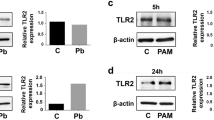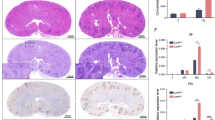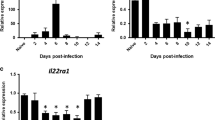Abstract
Although Moraxella catarrhalis and Neisseria meningitidis are important human pathogens, they often colonize the human respiratory tract without causing overt clinical symptoms. Both pathogens express structurally unrelated proteins that share the ability to stimulate the adhesion molecule CEACAM1 expressed on human cells. Here we demonstrate that the interaction of CEACAM1 with ubiquitous surface protein A1 expressed on M. catarrhalis or with opacity-associated proteins on N. meningitidis resulted in reduced Toll-like receptor 2–initiated transcription factor NF-κB–dependent inflammatory responses of primary pulmonary epithelial cells. These inhibitory effects were mediated by tyrosine phosphorylation of the immunoreceptor tyrosine-based inhibitory motif of CEACAM1 and by recruitment of the phosphatase SHP-1, which negatively regulated Toll-like receptor 2–dependent activation of the phosphatidylinositol 3-OH kinase–Akt kinase pathway. Our results identify a CEACAM1-dependent immune-evasion strategy.
This is a preview of subscription content, access via your institution
Access options
Subscribe to this journal
Receive 12 print issues and online access
$209.00 per year
only $17.42 per issue
Buy this article
- Purchase on Springer Link
- Instant access to full article PDF
Prices may be subject to local taxes which are calculated during checkout







Similar content being viewed by others
References
Akira, S., Uematsu, S. & Takeuchi, O. Pathogen recognition and innate immunity. Cell 124, 783–801 (2006).
O'Neill, L.A.J. TLRs play good cop, bad cop in the lung. Nat. Med. 11, 1161–1162 (2005).
Murphy, T.F. The role of bacteria in airway inflammation in exacerbations of chronic obstructive pulmonary disease. Curr. Opin. Infect. Dis. 19, 225–230 (2006).
Almoudi, O. Bacterial infection and risk factors in outpatients with acute exacerbation of chronic obstructive pulmonary disease: a 2-year prospective study. Respirology 2, 283–287 (2007).
Murphy, T.F., Brauer, A.L., Grant, B.J.B. & Sethi, S. Moraxella catarrhalis in chronic obstructive pulmonary disease: burden of disease and immune response. Am. J. Respir. Crit. Care Med. 172, 195–199 (2005).
N'Guessan, P.D. et al. Moraxella catarrhalis induces ERK- and NF-κB-dependent COX-2 and prostaglandin E-2 in lung epithelium. Eur. Respir. J. 30, 443–451 (2007).
Slevogt, H. et al. Moraxella catarrhalis induces inflammatory response of bronchial epithelial cells via MAPK and NF-κB activation and histone deacetylase activity reduction. Am. J. Physiol. Lung Cell. Mol. Physiol. 290, L818–L826 (2006).
Slevogt, H. et al. Moraxella catarrhalis is internalized in respiratory epithelial cells by a trigger-like mechanism and initiates a TLR2- and partly NOD1-dependent inflammatory immune response. Cell. Microbiol. 9, 694–707 (2007).
Caugant, D.A., Tzanakaki, G. & Kriz, P. Lessons from meningococcal carriage studies. FEMS Microbiol. Rev. 31, 52–63 (2007).
Murphy, T.F., Sethi, S. & Niederman, M.S. The role of bacteria in exacerbations of COPD - a constructive view. Chest 118, 204–209 (2000).
Sethi, S., Maloney, L., Grove, L., Wrona, C. & Berenson, C.S. Airway inflammation and bronchial bacterial colonization in chronic obstructive pulmonary disease. Am. J. Respir. Crit. Care Med. 173, 991–998 (2006).
Hill, D.J. & Virji, M. A novel cell-binding mechanism of Moraxella catarrhalis ubiquitous surface protein UspA: specific targeting of the N-domain of carcinoembryonic antigen-related cell adhesion molecules by UspA1. Mol. Microbiol. 48, 117–129 (2003).
Hill, D.J. et al. The variable P5 proteins of typeable and non-typeable Haemophilus influenzae target human CEACAM1. Mol. Microbiol. 39, 850–862 (2001).
Virji, M., Watt, S.M., Barker, S., Makepeace, K. & Doyonnas, R. The N-domain of the human CD66a adhesion molecule is a target for opa proteins of Neisseria meningitidis and Neisseria gonorrhoeae. Mol. Microbiol. 22, 929–939 (1996).
Gray-Owen, S.D. & Blumberg, R.S. CEACAM1: contact-dependent control of immunity. Nat. Rev. Immunol. 6, 433–446 (2006).
Lanier, L.L. Up on the tightrope: natural killer cell activation and inhibition. Nat. Immunol. 9, 495–502 (2008).
Barrow, A.D. & Trowsdale, J. You say ITAM and I say ITIM, let's call the whole thing off: the ambiguity of immunoreceptor signalling. Eur. J. Immunol. 36, 1646–1653 (2006).
Nagaishi, T. et al. SHP1 phosphatase-dependent T cell inhibition by CEACAM1 adhesion molecule isoforms. Immunity 25, 769–781 (2006).
Ravetch, J.V. & Lanier, L.L. Immune inhibitory receptors. Science 290, 84–89 (2000).
Bousquet, C. et al. Direct binding of p85 to sst2 somatostatin receptor reveals a novel mechanism for inhibiting PI3K pathway. EMBO J. 25, 3943–3954 (2006).
Dubois, M.J. et al. The SHP-1 protein tyrosine phosphatase negatively modulates glucose homeostasis. Nat. Med. 12, 549–556 (2006).
Soong, G., Reddy, B., Sokol, S., Adamo, R. & Prince, A. TLR2 is mobilized into an apical lipid raft receptor complex to signal infection in airway epithelial cells. J. Clin. Invest. 113, 1482–1489 (2004).
Arbibe, L. et al. Toll-like receptor 2-mediated NF-κB activation requires a RacI-dependent pathway. Nat. Immunol. 1, 533–540 (2000).
Chun, J. & Prince, A. Activation of Ca2+-dependent signaling by TLR2. J. Immunol. 177, 1330–1337 (2006).
Ruse, M. & Knaus, U.G. New players in TLR-mediated innate immunity - P13K and small Rho GTPases. Immunol. Res. 34, 33–48 (2006).
Hamilton, J.A. Colony-stimulating factors in inflammation and autoimmunity. Nat. Rev. Immunol. 8, 533–544 (2008).
Massengale, A.R. et al. Reduced interleukin-8 production by cystic fibrosis airway epithelial cells. Am. J. Respir. Cell Mol. Biol. 20, 1073–1080 (1999).
Patel, I.S. et al. Relationship between bacterial colonisation and the frequency, character, and severity of COPD exacerbations. Thorax 57, 759–764 (2002).
Chen, T. et al. Biliary glycoprotein (BGPa, CD66a, CEACAM1) mediates inhibitory signals. J. Leukoc. Biol. 70, 335–340 (2001).
Cuevas, B. et al. SHP-1 regulates Lck-induced phosphatidylinositol 3-kinase phosphorylation and activity. J. Biol. Chem. 274, 27583–27589 (1999).
de Jonge, M.I. et al. Conformational analysis of opacity proteins from Neisseria meningitidis. Eur. J. Biochem. 269, 5215–5223 (2002).
de Jonge, M.I., Hamstra, H.J., van Alphen, L., Dankert, J. & van der Ley, P. Mapping the binding domains on meningococcal Opa proteins for CEACAM1 and CEA receptors. Mol. Microbiol. 50, 1005–1015 (2003).
Boulton, I.C. & Gray-Owen, S.D. Neisserial binding to CEACAM1 arrests the activation and proliferation of CD4+ T lymphocytes. Nat. Immunol. 3, 229–236 (2002).
Lee, H.S.W., Ostrowski, M.A. & Gray-Owen, S.D. CEACAM1 dynamics during Neisseria gonorrhoeae suppression of CD4+ T lymphocyte activation. J. Immunol. 180, 6827–6835 (2008).
Nakayama, M. et al. Paired Ig-like receptors bind to bacteria and shape TLR-mediated cytokine production. J. Immunol. 178, 4250–4259 (2007).
An, H. et al. Phosphatase SHP-1 promotes TLR- and RIG-I-activated production of type I interferon by inhibiting the kinase IRAK1. Nat. Immunol. 9, 542–550 (2008).
Strassheim, D. et al. Phosphoinositide 3-kinase and Akt occupy central roles in inflammatory responses of Toll-like receptor 2-stimulated neutrophils. J. Immunol. 172, 5727–5733 (2004).
Strassheim, D., Kim, J.Y., Park, J.S., Mitra, S. & Abraham, E. Involvement of SHIP in TLR2-induced neutrophil activation and acute lung injury. J. Immunol. 174, 8064–8071 (2005).
Cuevas, B.D. et al. Tyrosine phosphorylation of p85 relieves its inhibitory sctivity on phosphatidylinositol 3-kinase. J. Biol. Chem. 276, 27455–27461 (2001).
Bergman, M.A. et al. CD4+ T cells and Toll-like receptors recognize Salmonella antigens expressed in bacterial surface organelles. Infect. Immun. 73, 1350–1356 (2005).
Lee, H.K., Lee, J. & Tobias, P.S. Two lipoproteins extracted from Escherichia coli K-12 LCD25 lipopolysaccharide are the major components responsible for Toll-like receptor 2-mediated signaling. J. Immunol. 168, 4012–4017 (2002).
Mogensen, T.H., Paludan, S.R., Kilian, M. & Ostergaard, L. Live Streptococcus pneumoniae, Haemophilus influenzae, and Neisseria meningitidis activate the inflammatory response through Toll-like receptors 2, 4, and 9 in species-specific patterns. J. Leukoc. Biol. 80, 267–277 (2006).
Berger, C.N., Billker, O., Meyer, T.F., Servin, A.L. & Kansau, I. Differential recognition of members of the carcinoembryonic antigen family by Afa/Dr adhesins of diffusely adhering Escherichia coli (Afa/Dr DAEC). Mol. Microbiol. 52, 963–983 (2004).
Leusch, H.G., Drzeniek, Z., Markospusztai, Z. & Wagener, C. Binding of Escherichia coli and salmonella strains to members of the carcinoembryonic antigen family - differential binding-inhibition by aromatic α-glycosides of mannose. Infect. Immun. 59, 2051–2057 (1991).
Cullen, B.R. Enhancing and confirming the specificity of RNAi experiments. Nat. Methods 3, 677–681 (2006).
Nordstrom, T., Forsgren, A. & Riesbeck, K. The Immunoglobulin D-binding part of the outer membrane protein MID from Moraxella catarrhalis comprises 238 amino acids and a tetrameric structure. J. Biol. Chem. 277, 34692–34699 (2002).
Acknowledgements
We thank J. Hellwig, F. Schreiber, A. Kuehn and M. Brant for technical assistance; J. Lippman for support in confirming the siRNA experiments; E. Hansen (University of Texas Southwestern Medical Center) for O35E and O35E.1; P. van der Ley (Laboratory of Vaccine Research, National Institute of Public Health and the Environment) for the parental E. coli strain PC2984 and the Opa J129– and Opa B128–expressing strains; C. Kirschning (Technical University Munich) for the pFlag-CMV-TLR2 expression plasmids; and H. Heine (Research Center Borstel) for GFP-tagged TLR2 plasmids. Supported by Deutsche Forschungsgemeinschaft (SL 153/1-1 to H.S. and OP 86/5-1 to B.O.), the Swedish Medical Research Council (K.R.) and Bundesministerium für Bildung und Forschung (project 13 of the German Chronic Obstructive Pulmonary Disease and Systemic Consequences-Comorbidities Network to H.S. and project B3 of the Pneumonia Research Network on Genetic Resistance and Susceptibility for the Evolution of Severe Sepsis to N.S.).
Author information
Authors and Affiliations
Contributions
H.S. planned the project; H.S. and B.B.S. designed and directed the experiments; B.B.S., S.Z. and H.S. did signaling analysis with immunoprecipitation, immunoblot analysis and ELISA; B.B.S. generated, characterized, produced and purified monoclonal antibody 18/20; A.H. did and analyzed the confocal laser-scanning microscopy; B.O., J.E. and S.Z. did the siRNA and overexpression experiments; B.O., P.D.N'G. and J.Z. provided advice for the experiments and analyzed data; B.B.S. and J.Z. did flow cytometry; W.Z. generated the CEACAM1 expression plasmids; K.R. produced recombinant UspA1; W.Z. and K.R. edited the manuscript; B.T.-W. isolated and characterized the PBECs; N.S. and L.L. supervised the research and contributed to manuscript criticism; and H.S. and B.B.S. wrote the manuscript.
Corresponding author
Supplementary information
Supplementary Text and Figures
Supplementary Figures 1–2 and Supplementary Methods (PDF 314 kb)
Rights and permissions
About this article
Cite this article
Slevogt, H., Zabel, S., Opitz, B. et al. CEACAM1 inhibits Toll-like receptor 2–triggered antibacterial responses of human pulmonary epithelial cells. Nat Immunol 9, 1270–1278 (2008). https://doi.org/10.1038/ni.1661
Received:
Accepted:
Published:
Issue Date:
DOI: https://doi.org/10.1038/ni.1661
This article is cited by
-
Human CEACAM1 is targeted by a Streptococcus pyogenes adhesin implicated in puerperal sepsis pathogenesis
Nature Communications (2023)
-
Activation of CEACAM1 with an agonistic monoclonal antibody results in inhibition of melanoma cells
Cancer Gene Therapy (2022)
-
Positive natural selection in primate genes of the type I interferon response
BMC Ecology and Evolution (2021)
-
Differential regulation of the transcriptomic and secretomic landscape of sensor and effector functions of human airway epithelial cells
Mucosal Immunology (2018)
-
Recent expansion and adaptive evolution of the carcinoembryonic antigen family in bats of the Yangochiroptera subgroup
BMC Genomics (2017)



